Twenty-five years ago to the day saw the release of one the end-of-the-century’s great, weird, spectacularly absurd blockbusters, the giddy, gleeful Face/Off, a blockbuster that is still a one-of-a-kind delight. John Woo’s hyberbolic bullet ballet delighted not only his own fanbase but those of its stars, Nicolas Cage and John Travolta, each playing the other in an improbable, impossible frenzy of high-concept action, one that earned its box-office mojo in a busy summer with a $245m take and even won over critics justifiably skeptical of its bizarre conceit.
Originally conceived of as a Birdman-of-Alcatraz style Die Hard-in-the-future (in an era when everyone was looking for the next Die Hard), Face/Off‘s main conceit was one landed on only years into its development. Unlike most actioners with their obvious good-guy-against-the-odds structure, Face/Off would not only pit two charismatic, parallel characters against each other: it would ask its stars to literally play each other, as one—Travolta, the highly decorated stuffed-shirt FBI Agent Sean Archer—would have the face of his archenemy Nicolas Cage’s assassin/crimelord Castor Troy grafted on to his own head, only then to have Troy do the same with Archer’s own face.
And yes, that is some Grade-A highfalutin’ nonsense right there.
Archer-as-Troy (now played by the gaunt-faced, bug-eyed Cage) ends up imprisoned and Troy-as-Archer (now played by beady-eyed, big-chinned Travolta) is free to run riot, initiating a high-stakes game of pursuit. Even aside from the comically absurd face-transplant procedure and the suspension of disbelief it requires, each scene subsequent to the switch allows the stars to wallow in the glee of playing each other, clearly conversant with the other’s (and their own) iconicity, tics, and features. Viewers, meanwhile, enjoy the frisson of each wait-that’s-supposedly-Travolta-in-Cage-doing/saying-that (or wait-that’s-supposedly-Cage-in-Travolta-doing/saying-that) moment.
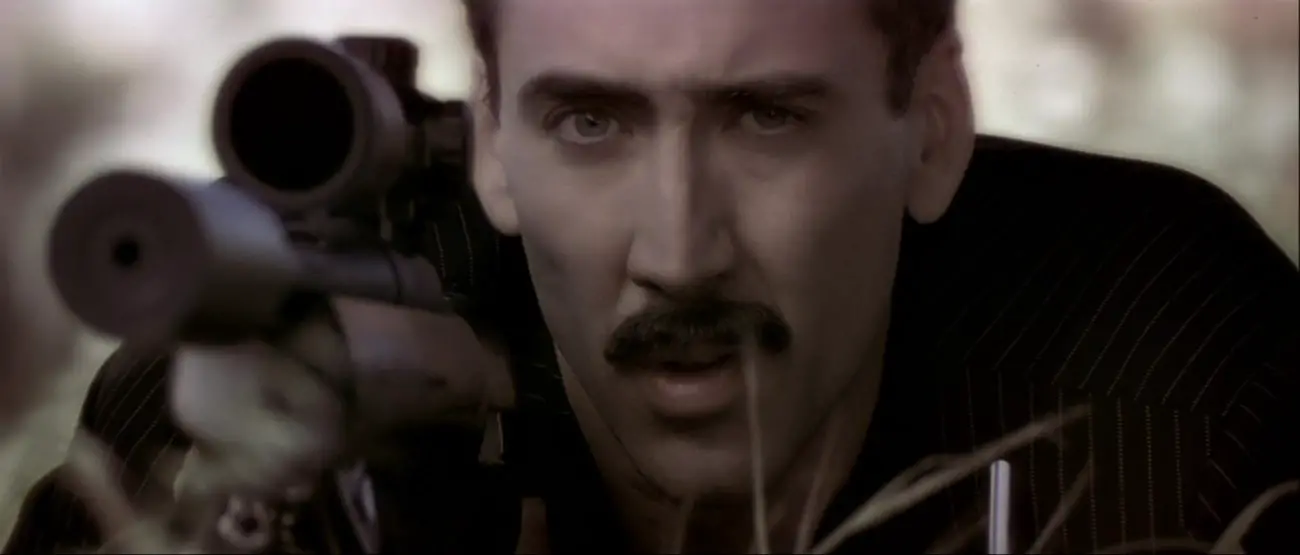
Let’s back up a bit. The plot begins well before the procedure, with assassin Castor Troy (Cage) conducting a hit on Agent Sean Archer (Travolta) as he enjoys a carousel ride with his young son, Michael. Troy’s shot hits its mark—straight through Archer’s chest—but then hits the boy, killing him, leaving Archer to grieve his loss. Why does Troy aim to kill Archer? No matter; the plot needs a reason to pit the two men as enemies and characterize Troy as a homicidal sociopath.
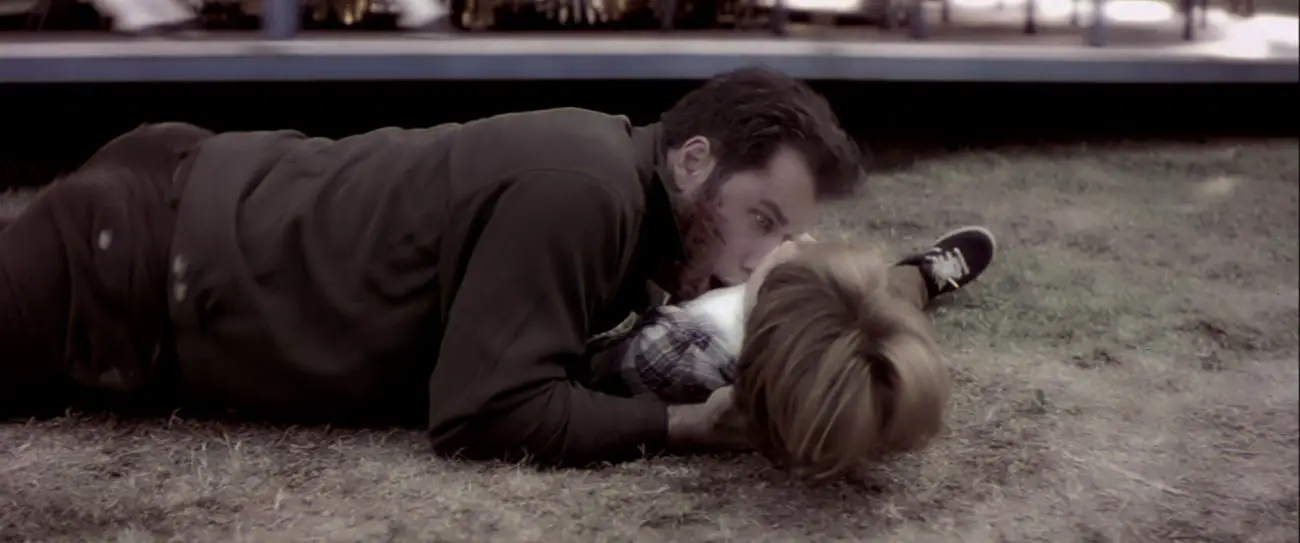
Six years later Archer is still devastated by the loss. He’s lost his connection with his wife (a physician, played by Joan Allen) and daughter Jamie (Dominique Swain) who’s experimenting with her identity, and devoted himself to his pursuit of Troy. Archer and his team successfully ambush and capture Troy and his younger brother, Pollux (Alessandro Nivola): Castor Troy is rendered comatose, Pollux sent to a special high-security prison. And to infiltrate and dismantle Troy’s operation, Agent Archer agrees to an unlikely ruse: undergoing a highly experimental face transplant procedure designed to give him Castor Troy’s face.
Just writing that out is its own special kind of nonsense.
Action films, as Yvonne Tasker notes, tend to adopt the same structure as the musical: scenes of exposition and narration are interrupted for musical numbers or action sequences. Face/Off never disappoints in this regard, opening with Troy’s hit on Archer and then later showing their first confrontation where Troy is captured, one that involves a helicopter, an airplane, and Cage’s body finally knocked after being thrust into a steel-grid wall by a jet-propulsion engine—the human body flying through space being another trope of the action film. The climactic chase in particular launches both men hundreds of feet into the air above open water.
Woo’s bullet-ballet action sequences are elongated and hyperbolized, every missing projectile setting off a cascade of sparks, every gunshot fired with balletic grace by diving, posturing gunmen. If Sergio Leone’s final standoff in The Good, The Bad, and The Ugly was between three men, Woo does the same with no fewer than six characters, his camera swooping between them like a hungry eagle. When the bullets fly, they do so in a cascade of close-ups, preening poses, exploding props, and—because for some reason the scene is set in a church—doves flying in slow motion.
And then there is the spectacle of the procedure itself. Even 25 years later and with its antiquated computer graphics and technologies, Woo’s stylized setups, characters’ reaction shots, and intimate close-ups sell this patently absurd scene with utter panache. A laser scalpel (probably a blood-red Sharpie) traces the outline of each man’s face and literally lifts it off like a mask: Cage/Troy’s face is then grafted onto Travolta/Archer’s head, while Travolta/Archer’s face is left to soak in a tub, where soon the plot will have need of it. At the same time (and to save time) a stylist unhygienically snips each man’s hair to mirror the other’s, just millimeters from their open missing-face wounds.
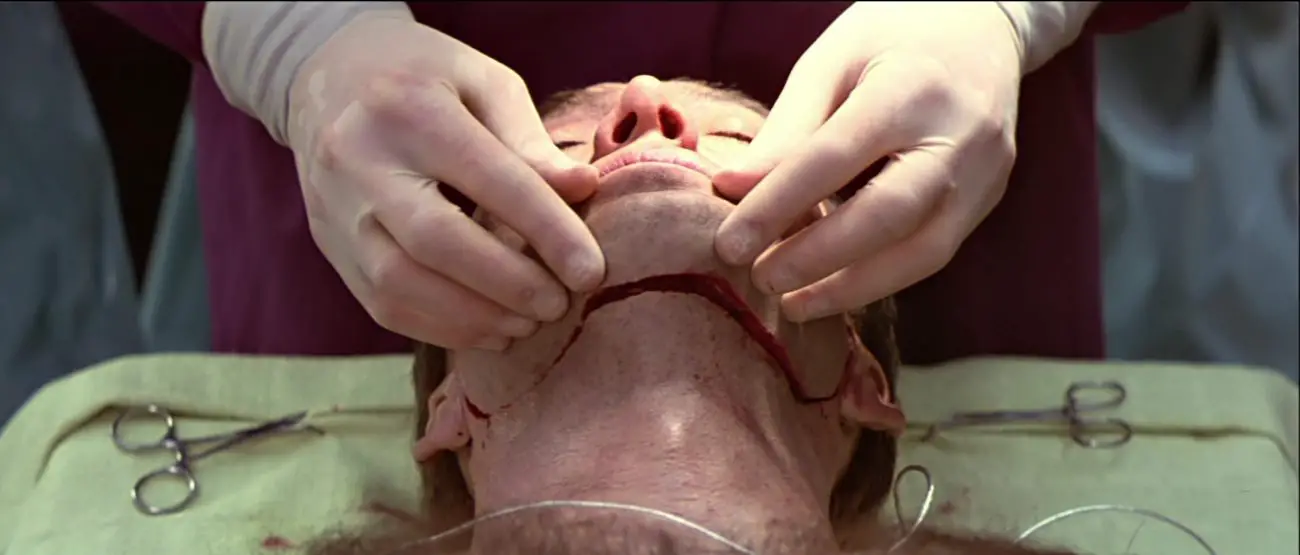
The whole operation (sorry) is rendered with such gravitas and sincerity it’s almost impossible not to giggle, and the scene itself is still an absolute delight, a cinematic highlight in a film that is superbly stylized throughout. The body models used are still-convincing superb recreations with clever animatronics mimicking their breathing and over six thousand body hairs separately injected into their chests. Once the operation is complete and the other plot quibbles addressed—such as how to account for Travolta’s hairline, voice, and paunch—Sean-Archer-wearing-the-face-of-Castor-Troy is sent, with hardly any recuperation, to infiltrate the high-security prison where brother Pollux is held.
Once again, it’s a completely absurd plan without any backup or failsafe, but it’s necessary to advance the plot, and of course, it doesn’t go well.
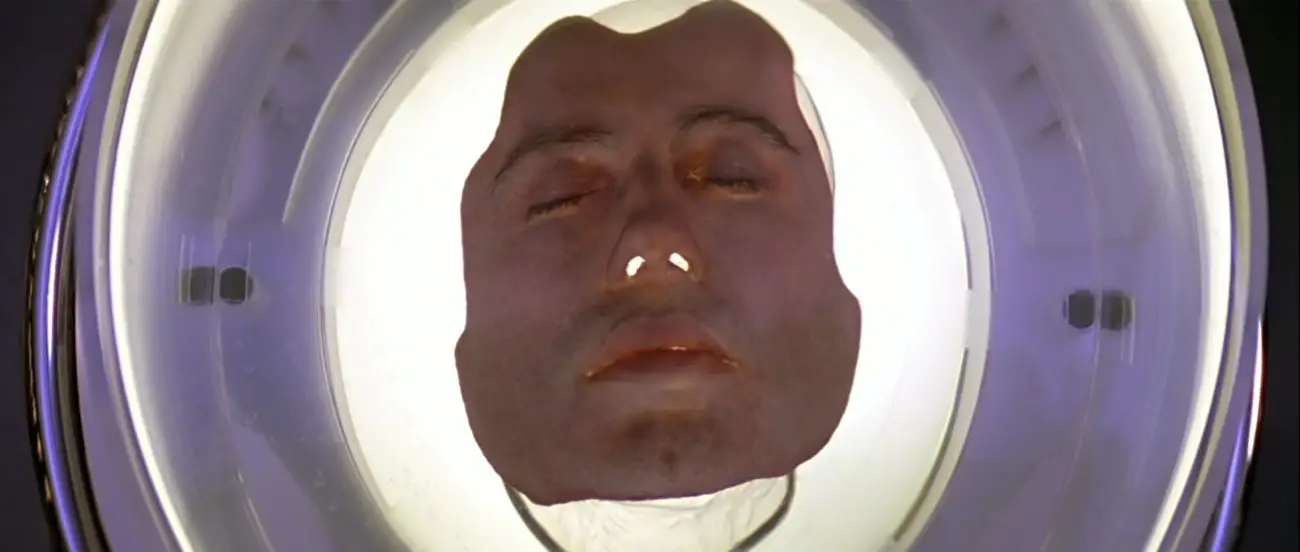
Perhaps Archer’s surgeon, Dr. Malcom Walsh (Colm Feore), might have thought to secure Travolta/Archer’s detached face, rather than leaving it unattended in a lidless container of viscous goo next to Cage/Troy’s bed. Or perhaps Archer’s FBI colleagues might have thought to secure Troy in a room where he would not have access to that face, to a telephone, or to Walsh’s entire damn laboratory and equipment. But then we could only have one kind of “Face/Off” and not the second, the enjoined conflict between two men, each of them with the other’s face, that gives the film its special jouissance. So of course Troy wakes from his coma, spots the detached face, puts two and two together, makes a phone call, and soon has Dr. Walsh at his beck and call, giving him the Travolta/Archer face, and Troy immediately kills the only of Archer’s colleagues who know of his undercover mission.
And for as much as Face/Off delivers in its first act, now its fun can really begin. For all the machinations it took to arrive there, now the lawman (Archer-as-Troy, played now by Cage) is imprisoned, where his adopted face/identity is suddenly a liability. The criminal (Troy-as-Archer, now played by Travolta) is not only freed but with the perfect cover of the decorated FBI agent and access to all of his resources. Scores of films have featured characters adopting the identity of another (for instance, Seconds, Gattaca) or going so far undercover they become the person they imitate (Deep Cover); others have exploited the mask as a conceit, metaphor, or symbol (including films as diverse as Black Girl, The Face of Another, Mask, The Mask, even the Batman films). But Face/Off is onto something special with each main character’s performance gleefully self-aware of the actor’s own and his castmate’s highly idiosyncratic appearance, mannerisms, and persona.
Travolta, who first burst on the television screen in the 1970s with his feathered-haired, dimple-chinned Welcome Back Kotter doofus, his mawkish hit single “Let Her In,” and the huge hits Saturday Night Fever, Grease, and Urban Cowboy, had lost his looks and appeal a bit in the 1980s before a 1990s comeback with Pulp Fiction. By the time of Face/Off, he was once again a known quantity, often playing off-kilter or otherwise unusual leads. His signature receding hairline became more prominent and a midbelly paunch more frequent, but he kept his roguish appeal. Cage came around later, having been cast by his uncle Francis Ford Coppola in several films including the hit Peggy Sue Got Married, where he antagonized his co-stars but won over viewers with his oddly affected mannerisms, bug-eyed stares, and loping gait.
Face/Off leans hard into both actors’ star personae. Cage, playing Archer inhabiting Troy, shows himself struggling to adopt Cage’s looney-tunes tendencies before going all in, widening his eyes and baring his teeth like fangs as he steels for battle. Travolta, playing Troy inhabiting Archer, uses his dance training to flounce about like a peacock and grin monstrously with his overbite full of gleaming choppers, all the while grousing openly about his (own!) looks—including “this nose, this hair, this ridiculous chin.” (That was a line Travolta reportedly disliked, yet the producers persuaded him it was motivated by intense jealousy of Travolta’s obvious good looks. Flattered, Travolta bought it, and the line stayed.)
In a way, this specific aspect of Face/Off—its known-quantity stars playing not so much fictional characters but versions of each other, with Travolta as Cage and Cage as Travolta—is so much fun it’s a wonder the conceit hasn’t been used more widely. What film buff wouldn’t want to see Bogart and Wayne, Crawford and Davis, Hoffman and Nicholson, Fonda and Keaton, how about Samuel L. Jackson and Denzel Washington, or even—as the producers of Face/Off had once imagined—Stallone and Schwarzenegger playing not “off” each other but literally playing each other?
With today’s blockbusters so often franchise entries designed to sustain intellectual property across multiple media and installments, part of Face/Off‘s appeal is that it exists in its own universe and no other: it’s not an adaptation, not part of a franchise, no prequels or sequels have ever appeared. It’s just what it is, and what it is is kind of glorious. For the record, twenty-five years later a sequel of sorts is in the works, characterized as a “reimagining” of the original, at Paramount, maybe even somehow with the newly-reinvigorated Cage (whose Castor Troy unambiguously dies at the end of Face/Off) aboard, according to Adam Wingard.
Nineteen ninety-seven was a time, Face/Off reminds us, when the internet was nascent, computer graphics crude, and Iomega Zip optical drives considered a reliable backup technology for highly confidential government databases. Facial transplant surgery was a new and promising technology, if not one performed with the absurd ease in the film: just a few years prior, the first full-face replant operation was performed on a nine-year-old Indian girl who had her face and scalp ripped off by a threshing machine. Her mother put the face into a plastic bag and drove over three hours to the hospital, where during a ten-hour operation her nerves and bloodvessels were successfully reconnected, and years later, the patient was studying to be a nurse.
Today, the procedure is more common, if still not common at all. According to Johns Hopkins, over 45 face transplants have been conducted in the last year. The procedure is highly invasive, requiring two teams of surgeons working simultaneously, and likely to require a monthlong hospital stay for complete recovery. Rehabilitation may take years, or even a lifetime—certainly not the few days Sean Archer spent before starting fistfights in prison. But it’s one that has saved or improved hundreds of lives. One of Archer’s FBI colleagues, by the way, has his ear transplanted in Face/Off: just this month, doctors reconstructed a human ear using the patient’s own tissue to create a 3D bioimplant. The imagery of their accomplishment suggests that what Face/Off once imagined, science has now made possible.
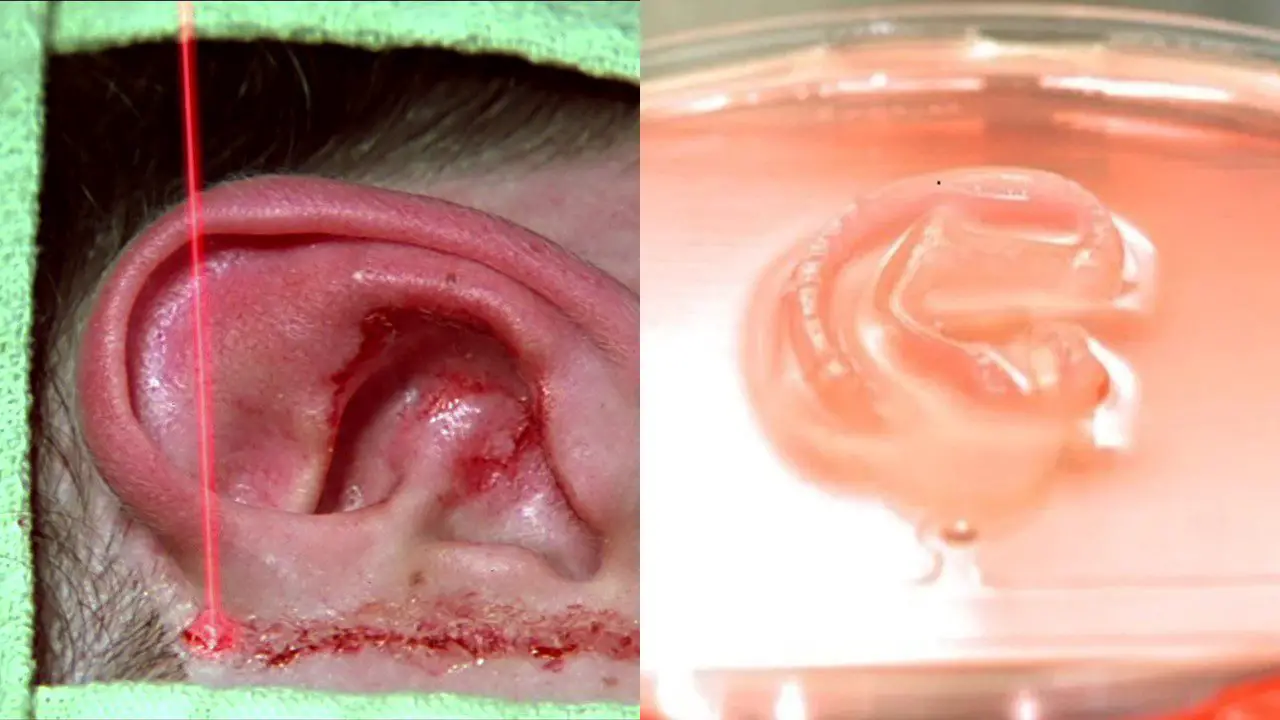
While Face/Off’s science, such as it is, serves only as a convenient canard for Travolta and Cage to mimic each other, the film’s action is all spectacle and melodrama of the highest—and most absurd—order. Castor Troy, we learn, is a father too, to little Adam, a young boy about the same age and size as Archer’s dead son Michael. Melodrama so often concerns the fragility of the nuclear family unit, subject to threats external or internal, and aims at its end to reaffirm the family. So when at the end of the film, when Sean Archer has vanquished Castor Troy and his trafficking empire, when he has had his own face restored, and when Travolta-as-Archer can return to his family and restore their trust and love, is there any surprise when be brings in tow little Adam? “Why don’t you show Adam his room?” he asks newly-adoring Jamie.
He doesn’t. Even. Ask. His. Wife. First.
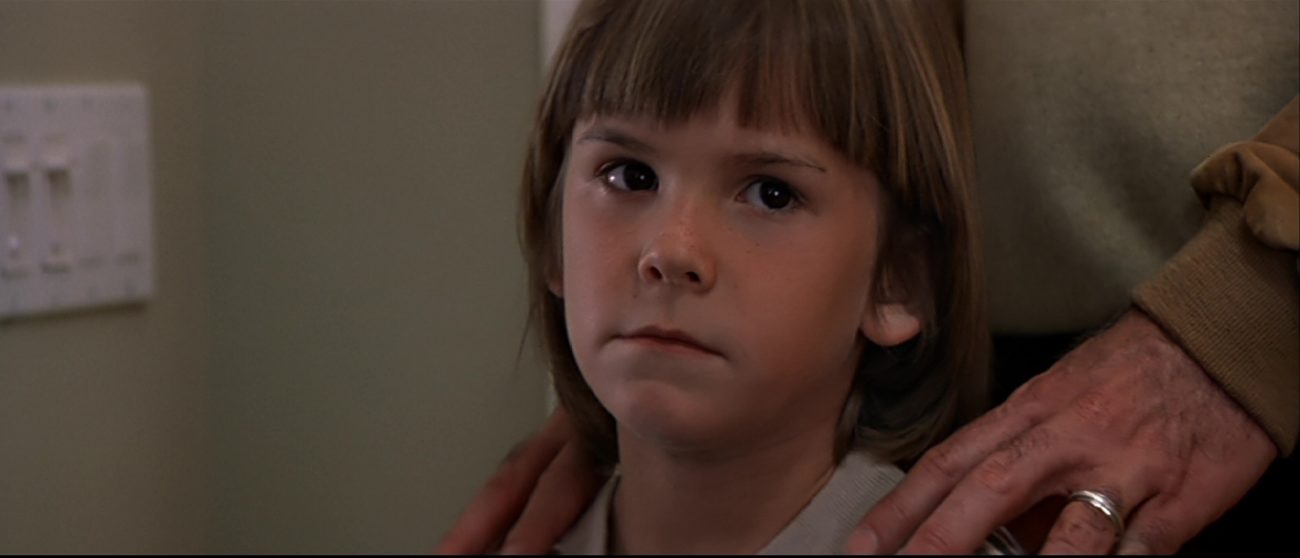
Ever-suffering Eve (the film is stacked with nonsensical religious allusions) is just supposed to grin and bear it, ever-suffering FBI wife that she is, for Sean’s man-grieving. Never mind the boy is the spawn of a homicidal sociopath who killed her and Sean’s own child, tried to kill her husband, and stole the man’s damn face. The family unit must be restored, and even though we’re supposed to believe workaholic Agent Archer will give his new family all the love and attention they deserve, it’s awfully hard to swallow a man deciding unilaterally he and his wife will raise someone else’s son.
But that’s Face/Off for you: a film that cares more about the spectacle of explosions more than the rules of physics, one that abandons the logic of continuity for the vicissitudes of the plot, one that makes a lark of a surgical technique in its infancy, and one that will gladly substitute one boy for another with the ease with which it grafted one’s face onto another. And with Woo’s signature bravura style and Cage and Travolta’s inspired scenery-chewing, it is still, twenty-five years later, great, great fun, a preposterous, absurd delight that never ceases—and has never ceased—to entertain.
Just don’t think too hard.




